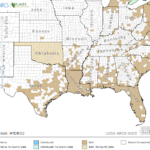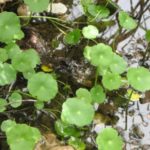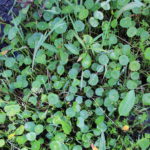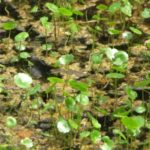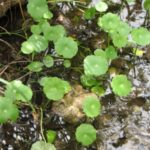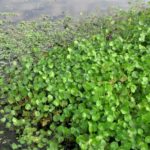Hydrocotyle spp.
USDA, NRCS. 2018. The PLANTS Database (http://plants.usda.gov, 28 March 2018). National Plant Data Team, Greensboro, NC 27401-4901 USA.
Illustration courtesy of University of Florida/IFAS Center for Aquatic and Invasive Plants. Used with permission and USDA-NRCS PLANTS Database / USDA NRCS. Wetland flora: Field office illustrated guide to plant species. USDA Natural Resources Conservation Service.
What is Water Pennywort?
Physical Characteristics
Leaves:
- Circular leaves
- About the size of a 1/2 dollar coin
- Shiny and leathery
- Leaf stalks attach to center of leaf
- Look like little umbrellas
Flowers:
- White, greenish or yellow
Fruit:
- Egg-shaped
- Flattened
Stem:
- Slender & creeping
- Form dense mats
Roots:
- Slender & creeping
- Roots at nodes
Where Does it Grow?
Water pennywort can be found in and near ponds, lakes, rivers, and marshes.
Pros and Cons of Water Pennywort
The seeds of pennywort are used occasionally as food by waterfowl. Submerged portions of all aquatic plants provide habitats for many micro and macro invertebrates. These invertebrates in turn are used as food by fish and other wildlife species (e.g. amphibians, reptiles, ducks, etc.). After aquatic plants die, their decomposition by bacteria and fungi provides food (called “detritus”) for many aquatic invertebrates.
What Type of Water Pennywort Do I Have?
There are three common types of Water Pennywort in Texas. Click on the buttons to learn more about each individual species.

